Arrive Delhi. You are met as you exit the aircraft and you will be taken to the immigration hall and directed to the correct visa counter. Your airport greeter will meet you once you have completed immigration formalities and will assist you with picking up the bags. In the arrival hall you will meet representative and you will be transferred to your hotel.
DELHI The capital of India, Delhi is home to 16 million people, making it the third largest city in India. The strategic location of the city made it an attractive location for invading armies, and it served as the capital for many great empires that ruled India. Many of these Empires built significant monuments, and whilst the Mughal and the British are the most visible, while driving through the city you will see ruins from previous capitals, the earliest dating back to the 12th century.
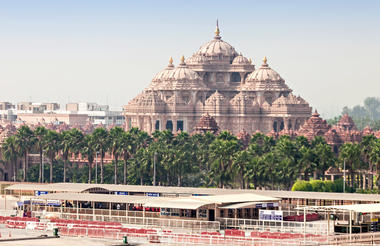

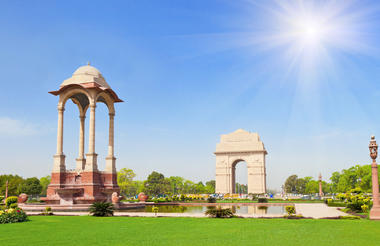
The morning is at leisure and we will have complimentary couples massage booked for you at the spa.
In the afternoon you will explore the Old City this morning, exploring the markets. Your will pass shops selling bangles, grocers, items used in weddings, silverware, clothes, spices and shoes. Sharing the same space are vendors with carts selling a variety of items, street side dentists, natural healers and cobblers. The Old city has space for all professions. You will ride cycle rickshaws through the narrow alleys, disembarking at the fascinating spice market before ending at the Jama Masjid, the Friday Mosque which dominates the skyline.
The afternoon takes you to one of the most famous mausoleums of Delhi - the Humayun’s Tomb. One of the earliest examples of a Mughal Garden Tomb, this mausoleum was designed by a Persian architect, and provided the prototype for future tombs, including the Taj Mahal. Recently taken over by the Agha Khan Trust, the gardens have been restored to their former glory, and the tomb and surrounding monuments restored.



Breakfast
You will transfer to the airport for your flight. You are met and transferred to your hotel.
UDAIPUR It is said that the ghost of Udaipur looks towards Chittorgarh, for it was after the tragic fall of that fort, that Udaipur, a fairy tale city of marble palaces and lakes came into existence. The City was founded by Maharana Udai Singh in 1559 and became the capital of the region of Mewar. The rulers of Mewar, the Sisodia Rajputs trace their dynasty to AD 566 and believe they are the defenders of Rajput honor. Unlike other Rajput royal families, this was a fiercely independent clan who refused to enter into matrimonial alliances with the Mughals or military alliances with the British. The city is dominated by the massive City Palace which overlooks the lovely Lake Pichola with its romantic island palaces.
From here you take a walk in the old city with your guide. Sharing space with cows, elephants, people, and the walk through the winding lanes is an interesting insight into lifestyles in what is referred to as “small town India”. Shops selling a variety of items, unexpected folk art decorating the walls of houses and small architectural gems like a latticed work Haveli window.
You will stop city at the workplace of a young man who is trying to keep his grandfather’s tradition of “Varak printing” alive. Varak is the rare and dying art of painting textiles with gold leaf. “Varak” is the paper thin 24 carat gold leaf that is used in the delicate skill of transferring it on to textiles and then made into designs. These textiles are used both in temples as well as for decorative purposes.
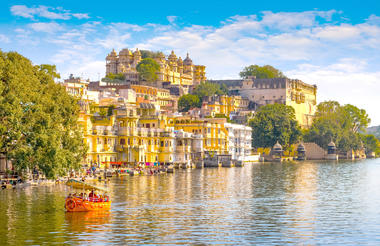
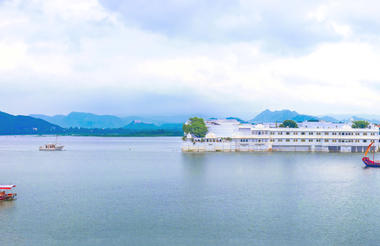
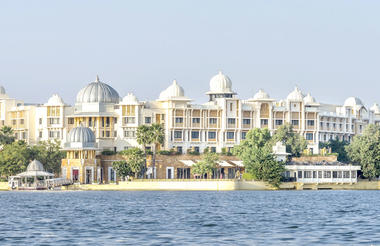
Breakfast
You are met in the lobby of the Oberoi Udaivilas in the morning. You pick up your bikes and start biking to Nagda Temples. The two hour tour takes you through the city and its outskirts, stopping at small hamlets which provide great photographic opportunities. Vehicles will be available for those who don’t want to bike, or who would like a shorter trip. After lunch at the Devigarh Palace you will return to Udaipur.
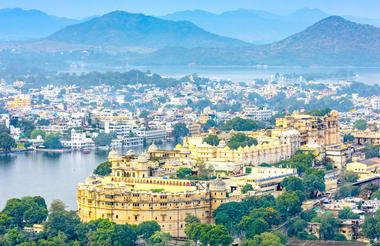
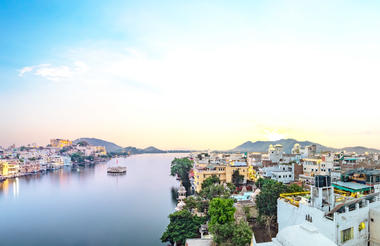
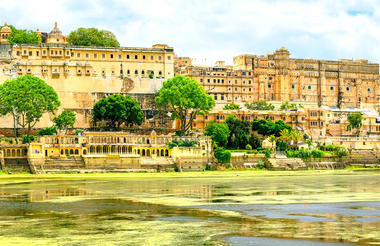
Breakfast
In the morning you visit the City Palace. The detailed art and workmanship is a tribute to the skills of local artisans and craftspeople. Built as a stepped palace encompassing a hill, the four palaces illustrate various architectural styles, reflecting prevailing influences, mostly Mughal and Rajput. In keeping with the claim of the royal family that they are “Surya vansh” – descendents of the Sun, the whole structure faces east, and a stunning bejeweled image of the sun greets you at the entrance. Also of interest here is the remarkable collection of Rajput miniature paintings and the Crystal Gallery with its rather eccentric collection of Object d’art, household items and furniture.
You will have a leisurely lunch while cruising the picturesque Lake Pichola surrounded by breathtaking views of the City Palace and Jagmandir Island. You will be welcomed with an Oberoi signature beverage and canapés, followed by a delectable main course and desserts created exclusively by the chef. You end the meal selection of rare teas and gourmet coffees, brewed on the boat. The rest of the day is at leisure to enjoy the hotel and the environs.



Breakfast
You will drive to Kumbalgarh. The scenery along the way is superb and you will see many vignettes of Rajasthani rural life. Among the sights you see are colorful villages, farms where an ancient system of irrigation using bullocks and a Persian wheel are still in practice, outdoor schools and the sartorially vibrant people who add a splash of colour to the countryside. There are endless opportunities for photography. This is an opportunity to see life in India outside the cities and towns.
You will start your Fort to temple hike today at the Kumbalgarh Fort. This superb fort located on a hilltop with its 15 kilometer walls snaking across the range, was considered impregnable, protected as it is by the hills of the rugged Aravali range. It was defeated only once by the armies of Akbar. This will be the start of your “Fort to Temple” walk through the Kumbalgarh Sanctuary. Walking downhill through the forests and meadows of this sanctuary you will exit close to the architecturally stunning marble temples of Ranakpur.
You will drive today to Jawai. Again, the scenery is supurb and there are endless opportunities for photography.



Breakfast, Lunch, Dinner
You will wake early today and you will take a safari, searching for leopards amongst the towering boulders and cliffs. You return to the camp and later you can take mountain bikes and explore the surrounding countryside After breakfast you will take mountain bikes and go off roading traveling through the rocky terrain and being able to explore areas the not accessible to the jeep. You will be accompanied by a guide on this two hour excursion This evening the safari takes you searching for leopards but also introduces you to the lifestyle of the Shepherds of Jawai and their families. You will stop at villages to visit with them, see small temples and shrines and will see the “Gaudhuli” or the cow dust hour, a name which is result of the dust raised by cattle returning home at this hour. It is a magical time to be out in the countryside.
Sunrise and Sunset are considered auspicious times in India, and as you drive through the village, you will see small rituals performed to welcome in the night and to ward off the dark spirits such as the evening “aarti” ceremony.



Breakfast, Lunch, Dinner
ou will drive to Jodhpur today the drive taking three hours.
In the afternoon at 3 PM you tour the blue city, the heritage walk taking you past lovely architectural features, shrines, small craft workshops and examples of folk art. This is a part of Jodhpur which is largely untouched and retains its atmosphere as a stop on the trade route through the desert.
Later you will browse in the little shops of Sadr Bazaar in the old city. You can shop for Jodhpur’s famous glass bangles, rugged leather mojri slippers made usually from camel leather, and the vivid tie and dye fabric; beautiful mirror worked fabric; and embroidered bedcovers and cushion covers which have been sourced from the neighboring state of Gujarat. You will stop at the most famous place in the market that makes the famous Jodhpur “mirchi pakora” – large chilies fried in batter, and the famous “lassI” shop that makes a variety of yogurt smoothies.
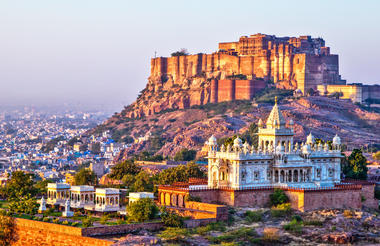
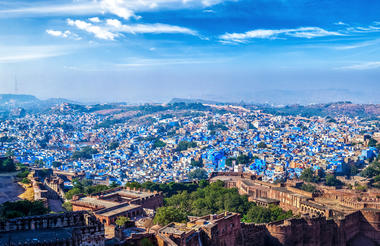
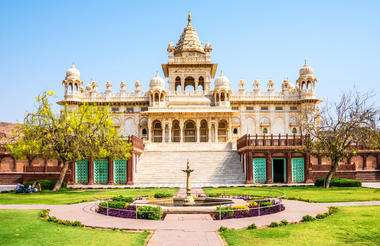
Breakfast
Leaving at 8:30 AM, you will drive to 1.5 hours to village of the Langas, desert musicians. This is the largest single congregation of a musical community in one village. As you approach the village, you will hear the sound of “riyaaz” drifting across the desert. This is the traditional practicing or honing of one’s music by young boys who learn this sacred tradition from their father or grandfather.
After a traditional greeting from women at the village you will either ride jeeps or camels to the sand dunes. This will be the “stage” where you watch a superb multigenerational concert, each musician using instruments which are either obsolete today or indigenous to the area.
This afternoon you have an exhilarating one and a half hours of “zipping” over the fort. The six line zip located inside the fort provides extraordinary views of the fort, lakes and valley. Expert guides accompany every tour.
Of all the forts in Rajasthan, very few compare to majesty of the Meherangarh Fort. The fort is divided into three sections – the public areas, the Maharajas palaces, and the zenana, or queens’ palaces. The zenana is decorated with exquisite sandstone filigree work. Within the fort is the museum which among its varied exhibits has an excellent collection of royal palanquins and the howdah section which has perhaps the finest collection of old ornate elephant howdahs in the world. You will have a private curated tour of the fort, led by Karni Singh the curator of the collection.
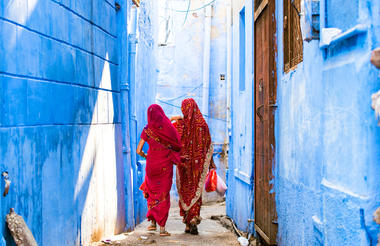

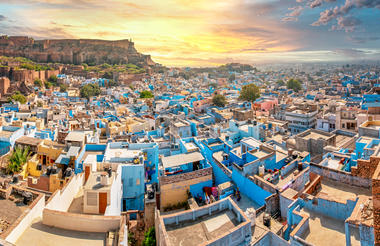
Breakfast
You will transfer to the airport and you will depart for Jaipur. You are met on arrival and you will be transferred to your hotel.
JAIPUR A labyrinth of fascinating bazaars, opulent palaces and a futuristic observatory, Jaipur was the inspiration of the ruler Sawai Jai Singh, who moved the capital from Amber in 1727. Jaipur was designed by a young architect from Bengal and together they planned a city along the ancient Hindu treatise of “Shilpa Shastra”, a science similar to the better known Feng Shui. Jaipur is laid out in a geometric grid of streets and squares making it one of the earliest planned cities in India. In honour of the visit of the Prince Edward, then the Prince of Wales, the City was painted a rich terracotta, a tradition which has continued through the years. This is the reason why Jaipur is often called the “pink city”. Today it serves as the State capital for Rajasthan.
You will stop for photographs at the Hawa Mahal, the ornate pink façade an icon of the city. This five story high “screen” composed of projected windows and balconies protected by fine latticed screens was destined to enable the ladies of the harem to observe the lively street scenes of the city from a position of privacy.
You visit the sprawling City Palace which, painted pink in keeping with the color theme of the old city, is a blend of predominately Rajput and Mughal styles of architecture. Within the palace complex are several museums including an interesting textile gallery exhibiting a fine selection of textiles and costumes from the royal collection. You will have a private tour of the residential rooms of the palace.
Markets in India are always a burst of color, activity, photographic moments and Jaipur more so as camels, tuks tuks, bicycle rickshaws and cars jostle for space on roads which were originally built for camel carts. With your tour host you will walk the street, learning from him the India that he grew up in before modern shops and malls took many professions off the streets in cities. Happily they still exist in small town India – the cobbler, the street side tailors; hair salons; key makers – everything you need in your daily life from buttons and bows to hair clips. It is a great insight into the lifestyle of middle class India. You will have lessons in stick fighting during this walk.
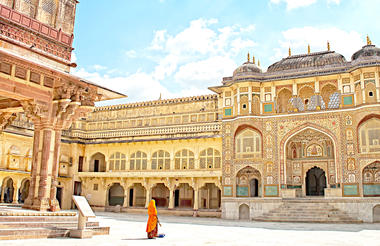


Breakfast
You take an early morning tour today, visiting the old and modern city as it is waking and preparing for the day. You take battery rickshaw from the Maharaja Jai Singh circle popularly referred to as “Statue Circle” and you drive to Central Park where locals gather for a morning of “laughing yoga”. From here you continue to the old city travelling through the narrow lanes stopping take a photograph at the iconic “Palace of the Winds”, beautiful in the morning sunlight. You stop by the flower market and you path leads you to the 300 year old Krishna temple in the old city which has a beautiful fresco and carved pillars. You will arrive in time for the morning singing and “aarti” Ceremony. During the walk you see the roadside tea shops, street food, pavement barbers, people at shrines greeting the morning sun – all preparing to start their day.
You continue to “shubhash chowk” where the milkmen gather bringing fresh milk in traditional cans, a sight unique to Jaipur and stop at the farmers market where local produce is sold.
You continue to the stunning Amber Fort. The Rajputs built their Forts on high hills and ridges giving them a 360 degree view of the surrounding area and protecting them from invading armies. Most of the forts they built were built as a defensive structure but included pleasure palaces, rich in art and architectural features. Amber is perhaps among the finest of all the fort palaces, and reflected the opulence and elegance of the nearby Mughal courts.
From Amber you will take a two hour hike to a tribal temple where each evening, monkeys and peacocks are fed at sunset.


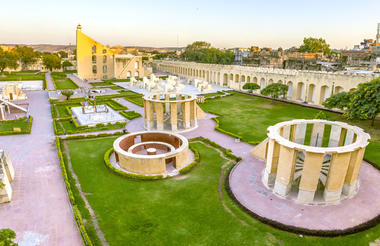
Breakfast
After breakfast you will drive to Agra.
AGRA This was the seat of the mighty Mughal Empire before it shifted its capital to Delhi, and it is home to some of their most inspired architectural creations including the Taj Mahal. In the 16th and 17th century, the Mughal Courts were at their most powerful, and were great patron of the arts, and Agra attracted artisans, poets and musicians from across India as well as Persia and Central Asia, transforming Agra into a cultural and architectural paradise.
This evening you will watch sunset from your private balcony sipping a cocktail followed by an elegant dinner. The balcony will be decorated with flowers and candles.



Breakfast, Dinner
This morning you visit the Taj Mahal when it is at least crowded. This monument was built by Shah Jahan for his wife Mumtaz Mahal. It took 12 years to build this sublime garden tomb, an image of the Islamic garden of paradise. It’s perfect proportions and exquisite craftsmanship was the work of artisans from both India and overseas. The Taj Mahal represents the wealth and luxury of Mughal art as seen in architecture.
You return to the hotel and the morning is at leisure. You will drive to Delhi today and will stop for cocktails and a light supper on the roof top al fresco restaurant at the Oberoi offering superb views over the city. You will continue to the airport and you will be assisted with checking in for your onward flight.




